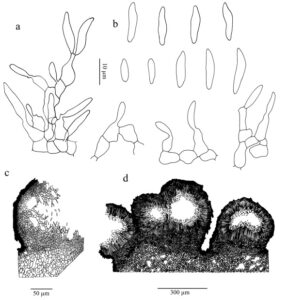Anthracoderma Speg., Boln Acad. nac. Cienc. Córdoba 11(2): 286 (1887) [1888]
Index Fungorum number: IF 7174, MycoBank number: MB 7174, Facesofungi number: FoF 07111, Fig. 1
Fungicolous. Sexual morph: undetermined. Asexual morph: Conidiomata dark brown to black, stromatic, pycnidial, carbonaceous, solitary to gregarious or confluent, superficial, subspherical in section view, often shortly stipitate, unilocular or multilocular, glabrous. Ostiole absent, opening by irregular splits in the apical wall. Conidiomatal wall composed of thick-walled, dark brown cells of textura epidermoidea in the basal part, progressively becoming paler to hyaline cells of textura angularis in the conidial hymenium. Conidiophores arising from the inner layer cells of locular wall, hyaline to subhyaline, irregular, branched,
septate, smooth-walled. Conidiogenous cells hyaline, holoblastic, occasionally sympodial, lageniform or irregular, terminal or intercalary and integrated, indeterminate, smooth-walled. Conidia hyaline, fusiform, straight or irregularly curved, aseptate, smooth-walled, eguttulate (Morgan-Jones 1977; Sutton 1980).
Type species – Anthracoderma hookeri Speg., Boln Acad. nac. Cienc. Córdoba 11(2): 286 (1887) [1888]
Notes – Anthracoderma hookeri was collected from the fructification of Cyttaria hookeri (Cyttariaceae) (Sutton 1980). Petrak and Sydow (1935) studied the holotype of Anthracoderma and regarded it as a valid genus. Morgan-Jones (1977) and Sutton (1980) re-described the genus. Besides the type species, another two species are accepted in the genus, A. duvidosum Viégas, and A. selenospermum Speg. The genus has no molecular data and therefore, fresh collections are needed to epitypify the genus and to place it in its natural classification.
Distribution – Argentina, Brazil, Chile (Sutton 1980, https://www.gbif.org/).

Fig. 1. Anthracoderma hookeri (redrawn from Sutton 1980, Nag Raj and DiCosmo 1980). a Conidiophores, conidiogenous cells and developing conidia. b Conidia. c Enlarge view of conidiomatal wall. d Vertical section of conidioma.
Species
